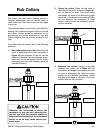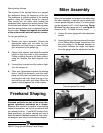
G8622 Tilting Spindle Sliding Table Shaper -27-
Figure 41. Rub collar installed above cutter.
Figure 42. Rub collar between two cutters.
3. Between two cutters: Using a rub collar
between two cutters, as in Figure 42, has
the distinct advantage of performing two cuts
at once or eliminating the need to change
cutters for two different operations. Notice
that part of the edge is left uncut. The uncut
portion rides on the rub collar.
2. Above the cutter: When the rub collar is
used above the cutter as seen in Figure 41,
the cut cannot be seen. This offers some
advantage: the stock is not affected by slight
variations in thickness and accidental lifting
will not damage the workpiece. If lifting
occurs, simply correct the mistake by repeat-
ing the operation.
Figure 40. Rub collar installed below cutter.
Rub Collars
Rub collars are used when shaping curved or
irregular workpieces, such as arched doors or
round table tops. Rub collars also limit the depth
of your cut.
There are two types of rub collars—solid and ball-
bearing. We recommend against the use of solid
rub collars. Grizzly carries an extensive line of
ball bearing rub collars designed for use with
Grizzly shapers. See the current catalog for list-
ings.
Rub collars may be used in any of the following
positions:
1. Rub collar below the cutter: When the rub
collar is used below the cutter as shown in
Figure 40, the progress of the cut can be
observed. However, any unintentional move-
ment may lift the workpiece into the cutter,
damaging your work and creating a potential
kickback situation.
Whenever the cutterhead is above the
workpiece, or you can see it spinning dur-
ing use, you must take extreme caution to
keep your hands away from the cutterhead.
Failure to do so may cause serious per-
sonal injury.


















